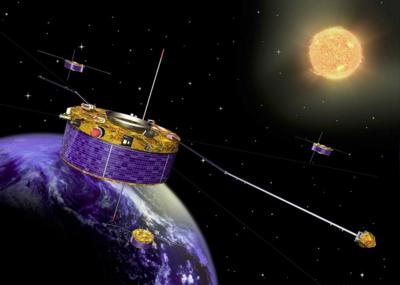Mon, Sep 30, 2013
Four Identical Spacecraft Have Been Studying The Earth's Magnetospehere In Three Dimensions
Since 2000, the four identical satellites of the Cluster quartet have been probing Earth’s magnetosphere in three dimensions. This week, two of them made their closest-ever approach, just two-and-a-half miles, enabling valuable data to be acquired with unprecedented detail.

In an orbital reconfiguration that will help to maintain the mission’s life span, two of the four satellites achieved their closest-ever separation on 19 September, closing to within just 2.5 miles of each other as they orbited at up to 14,000 mph high above Earth. “We’re optimizing the Cluster formation so that the separation between Cluster 1 and the duo of Cluster 3 and 4 – which are on almost identical orbits – is kept below 62 miles when the formation crosses Earth’s magnetic equator,” says Detlef Sieg, working on Cluster flight dynamics at ESA’s ESOC operations centre in Darmstadt, Germany.
The formation will hold three of the four satellites close together at lower altitudes, optimizing the range of science observations. “Following the closest-ever approach on 30 August, we achieved a new mission record with C1 and C3 (September 19), at just 4 km (2.4 miles) around 0912 GMT,” says Juergen Volpp, Spacecraft Operations Manager at ESOC.
The main challenge in achieving the formation was to exclude any collision risk and to avoid further maneuvres, which would interrupt science activities. “We can determine the satellites’ orbits with an accuracy better than 0.1 km (328 feet),” says Detlef Sieg, “so we knew we could achieve the formation with sufficient allowance for safety.”
The new formation will be held until early November before the separations are increased to more than 621 miles. “When we started Cluster, we believed that a separation of 500 km 310 miles) was the smallest required by science,” says ESA’s Phillipe Escoubet, Cluster Mission Scientist. “However, it turns out that the physical processes at very small scales are very important and this is why we have decided to decrease the separation distance to more than a factor 100 to just 4 km (2.4 miles), as it will allow us to study electromagnetic waves in the radiation belts with unprecedented detail.”
(Image provided by ESA)
More News
Takeoff Roll The process whereby an aircraft is aligned with the runway centerline and the aircraft is moving with the intent to take off. For helicopters, this pertains to the act>[...]
“We’re proud of the hard work that went into receiving this validation, and it will be a welcome relief to our customers in the European Union. We couldn’t be mor>[...]
"Aircraft Spruce is pleased to announce the acquisition of the parts distribution operations of Wag-Aero. Wag-Aero was founded in the 1960’s by Dick and Bobbie Wagner in the >[...]
IDENT Feature The special feature in the Air Traffic Control Radar Beacon System (ATCRBS) equipment. It is used to immediately distinguish one displayed beacon target from other be>[...]
Aero Linx: Pararescue Air Force Pararescuemen, also known as PJs, are the only DoD elite combat forces specifically organized, trained, equipped, and postured to conduct full spect>[...]
 ANN's Daily Aero-Term (05.10.24): Takeoff Roll
ANN's Daily Aero-Term (05.10.24): Takeoff Roll Aero-News: Quote of the Day (05.10.24)
Aero-News: Quote of the Day (05.10.24) Aero-News: Quote of the Day (05.11.24)
Aero-News: Quote of the Day (05.11.24) ANN's Daily Aero-Term (05.11.24): IDENT Feature
ANN's Daily Aero-Term (05.11.24): IDENT Feature ANN's Daily Aero-Linx (05.11.24)
ANN's Daily Aero-Linx (05.11.24)



